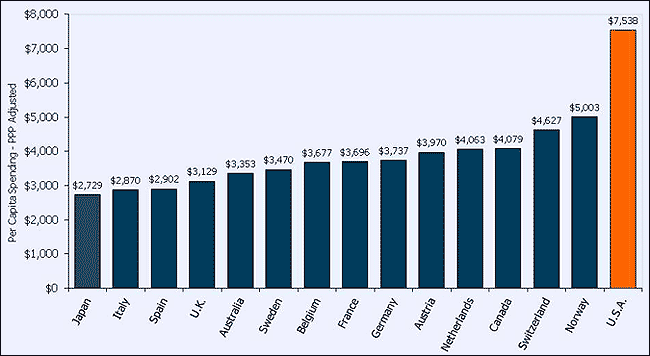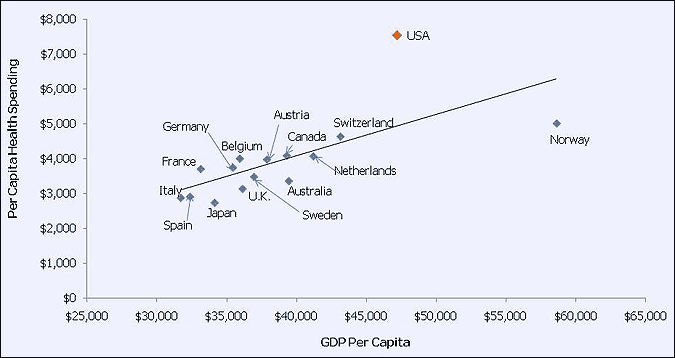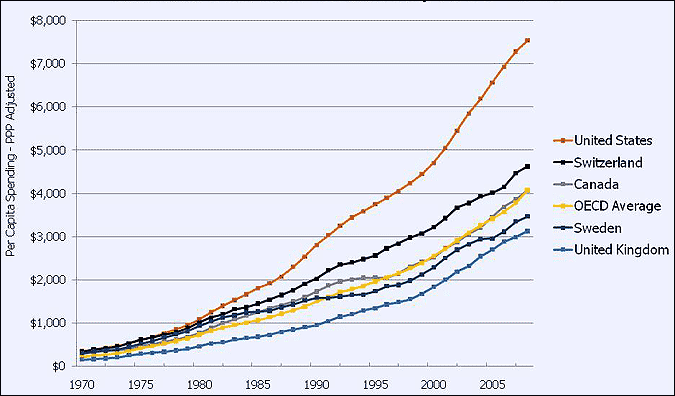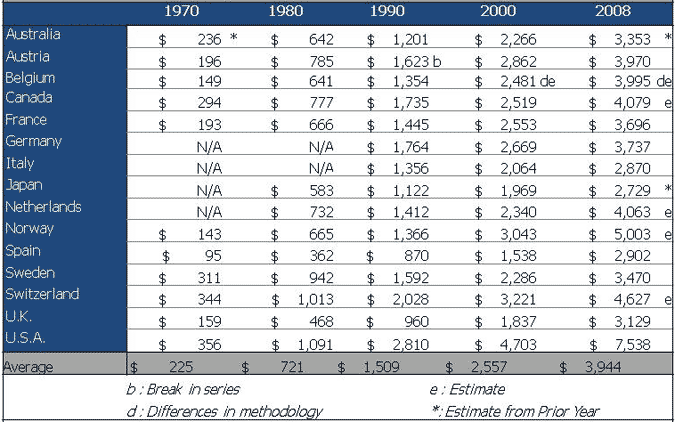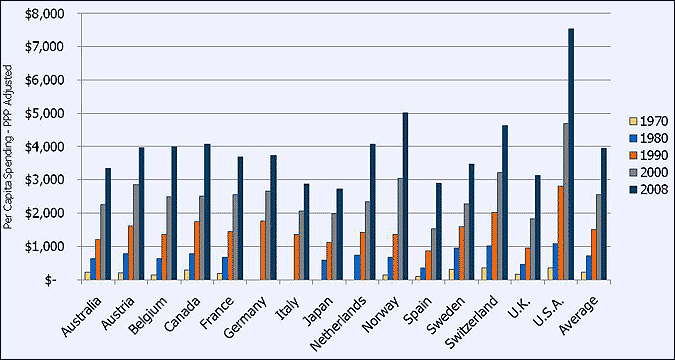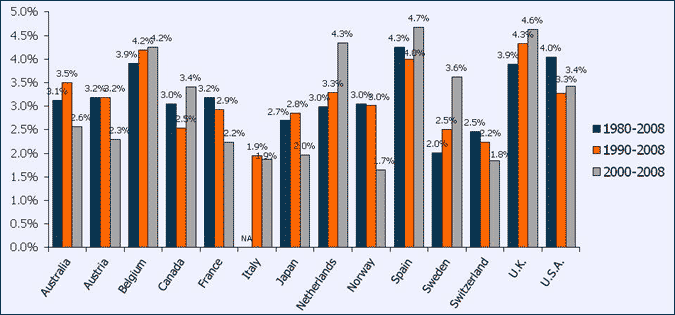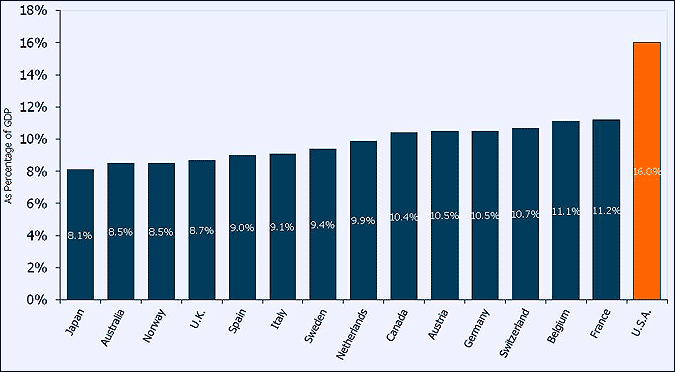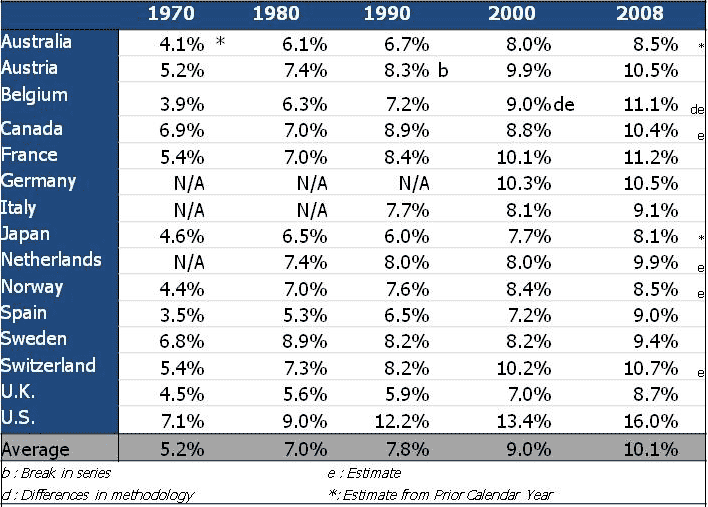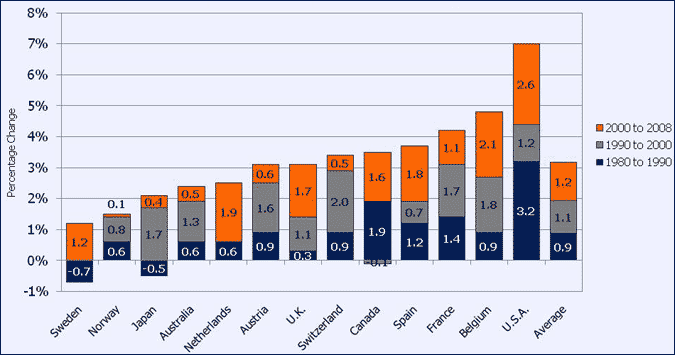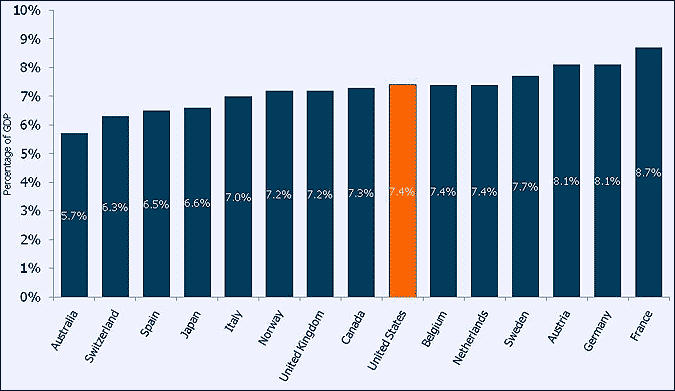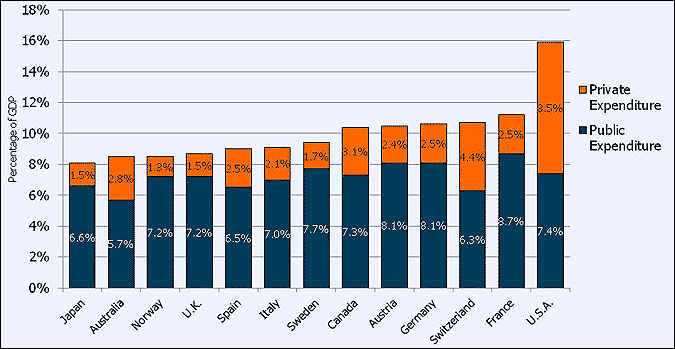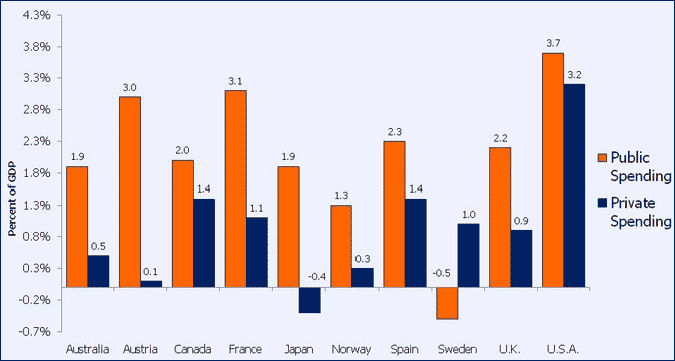Snapshots: Health Care Spending in the United States & Selected OECD Countries
Health spending is rising faster than incomes in most developed countries, which raises questions about how countries will pay for their future health care needs. The issue is particularly acute in the United States, which not only spends much more per capita on health care, but also has had one of the highest spending growth rates. Both public and private health expenditures are growing at rates which outpace comparable countries. Despite this higher level of spending, the United States does not achieve better outcomes on many important health measures. This paper uses information from the Organisation for Economic Co-operation and Development (OECD)1 to compare the level and growth rate of health care spending in the United States to those of other OECD countries.
It is reasonably well known that the United States spends more per capita on health care than other countries. What may be less well known is that the United States still has one of the highest growth rates in health care spending. Health care spending around the world is generally rising faster than overall economic growth, so almost all countries have seen health care spending increase as a percentage of their gross domestic product (GDP) over time. In the United States, which has both a high level of health spending per capita and a relatively high rate of real growth in spending, the share of GDP devoted to health care spending grew from 9% of GDP in 1980 to 16% of GDP in 2008. This 7 percentage-point increase in health spending as a share of GDP is one of the largest across the OECD.
This paper analyzes data on health spending and national income from the 15 Organisation for Economic Co-operation and Development (OECD) countries who rank in the top three-fifths of per capita national income and aggregate national income. The OECD is an international organization that collects and analyses data on various social and economic indicators. Countries with relatively low per capita income were excluded because they have fewer resources to devote to health care and, therefore, do not provide a reasonable comparison with American spending levels.2 Similarly, smaller developed countries face different challenges in administering their healthcare system and were also excluded. Footnotes are provided where the OECD data show a break in series, indicating that the OECD data may not be comparable over the entire period being analyzed. Germany is excluded from the time series exhibits because data is not comparable across the period of reunification.3The level of total health expenditure per capita is shown in U.S. dollars, adjusted for purchasing power parity (PPP).4 Spending totals for Japan and Australia are reported from 2007 because 2008 data is not currently available. Data on growth rates and health care as a percentage of GDP are based upon the national currency of each country, with growth rates adjusted to remove the impact of inflation.5
Health Spending Per Capita:
Exhibit 1 shows per capita health expenditures for 2008 in U.S. dollars purchasing power parity. Health spending per capita in the United States is much higher than in other countries – at least $2,535 dollars, or 51%, higher than Norway, the next largest per capita spender. Furthermore, the United States spends nearly double the average $3,923 for the 15 countries.
Exhibit 1
Total Health Expenditure per Capita, U.S. and Selected Countries, 2008
| Source: Organisation for Economic Co-operation and Development (2010), “OECD Health Data”, OECD Health Statistics (database). doi: 10.1787/data-00350-en (Accessed on 14 February 2011). Notes: Data from Australia and Japan are 2007 data. Figures for Belgium, Canada, Netherlands, Norway and Switzerland, are OECD estimates. Numbers are PPP adjusted. |
While an increasing GDP per capita is associated with increased health spending, the United States is an outlier, spending more than similarly wealthy countries. Exhibit 2 shows the relationship between a country’s GDP per capita and its per capita health care expenditure.
Exhibit 2
Total Health Expenditure per Capita and GDP per Capita, US and Selected Countries, 2008
| Source: Organisation for Economic Co-operation and Development (2010), “OECD Health Data”, OECD Health Statistics (database). doi: 10.1787/data-00350-en (Accessed on 14 February 2011). Notes: Data from Australia and Japan are 2007 data. Figures for Belgium, Canada, Netherlands, Norway and Switzerland, are OECD estimates. |
Health Spending and Annual Growth Rates:
In addition to higher health spending, the United States is increasing its spending faster than other countries. Exhibit 3 illustrates the trend in health spending among five countries. The United States’ higher growth rate in the 1990s and the 2000s ensured that it spent far more than other selected countries. While the United States had a slower rate of growth in the early 1990s, the late 1980s and 2000s were defined by an accelerated growth rate.
Exhibit 3
Growth in Total Health Expenditure Per Capita, U.S. and Selected Countries, 1970-2008
| Source: Organisation for Economic Co-operation and Development (2010), “OECD Health Data”, OECD Health Statistics (database). doi: 10.1787/data-00350-en (Accessed on 14 February 2011). Notes: Data from Australia and Japan are 2007 data. Figures for Belgium, Canada, Netherlands, Norway and Switzerland, are OECD estimates. Numbers are PPP adjusted. Break in series: CAN(1995); SWE(1993, 2001); SWI(1995); UK (1997). Numbers are PPP adjusted. Estimates for Canada and Switzerland in 2008. |
Exhibits 4A and 4B document total health expenditure per capita, holding constant both inflation and adjusting for, purchasing power parity. Over the last thirty years the difference between the United States’ spending and comparable countries has widened.
Exhibit 4A
Total Health Expenditures, Per Capita Spending in US Dollars and PPP adjusted
| Source: Organisation for Economic Co-operation and Development (2010), “OECD Health Data”,OECD Health Statistics (database). doi: 10.1787/data-00350-en (Accessed on 14 February 2011). Notes: Data from Australia and Japan are 2007 data. 2008 figures for Belgium, Canada, Netherlands, Norway and Switzerland, are OECD estimates. 2000 figured for Belgium are OECD estimates. Numbers are PPP adjusted. Break in Series AUS (1998); AUSTRIA(1990); BEL(2003, 2005); CAN(1995); FRA(1995); GER(1992); JAP(1995); NET(1998, 2003); NOR(1999); SPA(1999, 2003); SWE(1993, 2001); SWI(1995); UK (1997. Starting in 1993 Belgium used a different methodology. |
Exhibit 4B
Total Health Expenditure Per Capita, U.S. and Selected Countries, 1970, 1980, 1990, 2000, 2008
| Source: Organisation for Economic Co-operation and Development (2010), “OECD Health Data”, OECD Health Statistics (database). doi: 10.1787/data-00350-en (Accessed on 14 February 2011). Notes: Data from Australia and Japan are 2007 data. Figures for Belgium, Canada, Netherlands, Norway and Switzerland, are OECD estimates. Numbers are PPP adjusted. Break in Series AUS (1998); AUSTRIA(1990); BEL(2003, 2005); CAN(1995); FRA(1995); GER(1992); JAP(1995); NET(1998, 2003); NOR(1999); SPA(1999, 2003); SWE(1993, 2001); SWI(1995); UK (1997). Starting in 1993 Belgium used a different methodology. |
Exhibit 5 shows the average annual growth rate for per capita health spending, adjusted for inflation in each country.6 The U.S. average annual growth rate (4% from 1980 to 2008) was the second highest among the countries analyzed throughout the selected period. The combination of a relatively high level of per capita health spending in 1980, and a relatively high growth rate between 1980 and 2008, resulted in the very high level of health spending per capita that we now see in the United States. For example, while Switzerland and Sweden had levels of per capita health spending comparable to the U.S. in 1980 (Exhibit 4), they had much lower average annual growth rates in health spending than the U.S. over the 1980 to 2008 period. Other countries with relatively high average annual growth rates over the 1980 to 2008 period (e.g., Spain, Norway, United Kingdom) started the period at relatively low levels of health spending per capita relative to the U.S. While the annual growth rate between 1990 and 2008 and between 2000 and 2008, are more modest, the United States still matched or exceeded the growth rate of more than half of the fifteen countries analyzed.
Exhibit 5
Average Annual Growth Rates in Total Health Expenditure Per Capita, U.S. and Selected Countries, 1980 to 2008, 1990 to 2008, and 2000 to 2008
| Source: Organisation for Economic Co-operation and Development (2010), “OECD Health Data”, OECD Health Statistics (database). doi: 10.1787/data-00350-en (Accessed on 14 February 2011). Notes: Data from Australia and Japan are 2007 data. Figures for Belgium, Canada, Netherlands, Norway and Switzerland, are OECD estimates. Numbers are PPP adjusted. Break in Series AUS (1998); AUSTRIA(1990); BEL(2003, 2005); CAN(1995); FRA(1995); GER(1992); JAP(1995); NET(1998, 2003); NOR(1999); SPA(1999, 2003); SWE(1993, 2001); SWI(1995); UK (1997). Starting in 1993 Belgium used a different methodology. |
Health Spending and National Income:
Another way to look at relative health spending is to look at how much of a country’s national income is spent on health care. Economist often use a country’s total production, or its GDP, as a measurement of its national income. Exhibit 6 shows that in 2008, health expenditures in the U.S. equaled 16% of GDP, almost five percentage points higher than for any other country in the analysis. The U.S. has committed a higher share of GDP to health care than most other nations since at least the 1970s, although there were several other countries with comparable levels in the 1970s and 1980s (Exhibit 7A and 7B). Since that time, health spending as a share of GDP has grown in the U.S. relative to other countries.
Exhibit 6
Total Health Expenditure as a Share of GDP, U.S. and Selected Countries, 2008
| Source: Organisation for Economic Co-operation and Development (2010), “OECD Health Data”, OECD Health Statistics (database). doi: 10.1787/data-00350-en (Accessed on 14 February 2011). Notes: Data from Australia and Japan are 2007 data.Figures for Belgium, Canada, Netherlands, Norway and Switzerland, are OECD estimates. |
Exhibit 7A
Total Expenditure on Health as a Share of GDP
| Source: Organisation for Economic Co-operation and Development (2010), “OECD Health Data”, OECD Health Statistics (database). doi: 10.1787/data-00350-en (Accessed on 14 February 2011). Notes: Data from Australia and Japan are 2007 data. Figures for Belgium, Canada, Netherlands, Norway and Switzerland, are OECD estimates. Numbers are PPP adjusted. Break in Series AUS (1998); AUSTRIA(1990); BEL(2003, 2005); CAN(1995); FRA(1995); GER(1992); JAP(1995); NET(1998, 2003); NOR(1999); SPA(1999, 2003); SWE(1993, 2001); SWI(1995); UK (1997). Starting in 1993 Belgium used a different methodology. |
Exhibit 7B
Total Expenditure on Health as a Share of GDP, U.S. and Selected Countries, 1970, 1980, 1990, 2000, 2008
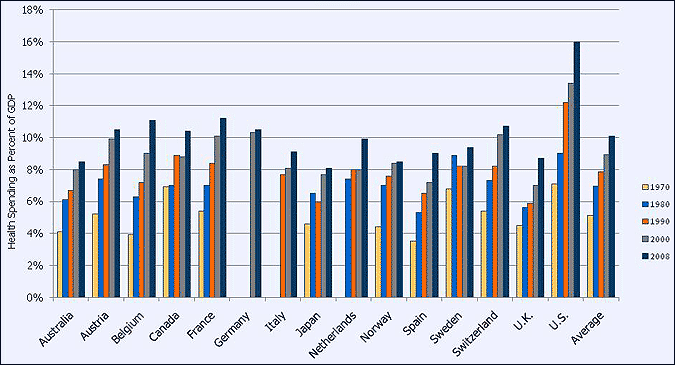
| Source: Organisation for Economic Co-operation and Development (2010), “OECD Health Data”, OECD Health Statistics (database). doi: 10.1787/data-00350-en (Accessed on 14 February 2011). Notes: Data from Australia and Japan are 2007 data. Figures for Belgium, Canada, Netherlands, Norway and Switzerland, are OECD estimates. Numbers are PPP adjusted. Break in Series AUS (1998); AUSTRIA(1990); BEL(2003, 2005); CAN(1995); FRA(1995); GER(1992); JAP(1995); NET(1998, 2003); NOR(1999); SPA(1999, 2003); SWE(1993, 2001); SWI(1995); UK (1997). Starting in 1993 Belgium used a different methodology. |
Between 1980 and 2008, the U.S. share of GDP devoted to health grew by 7 percentage points, almost 4 percentage points more than the 15-country average (Exhibit 8). In addition to the largest total increase in health spending as a percentage of GDP, the United States saw the largest increase of any country from 2000 to 2008 with health spending consuming 2.6% more of GDP than it did in 2000.
Exhibit 8
Percentage Point Change in Total Health Expenditure as a Share of GDP, U.S. and Selected Countries, by Decade.
| Source: Organisation for Economic Co-operation and Development (2010), “OECD Health Data”, OECD Health Statistics (database). doi: 10.1787/data-00350-en (Accessed on 14 February 2011). Notes: Data from Australia and Japan are 2007 data. Figures for Belgium, Canada, Netherlands, Norway and Switzerland, are OECD estimates. Numbers are PPP adjusted. Break in Series AUS (1998); AUSTRIA(1990); BEL(2003, 2005); CAN(1995); FRA(1995); GER(1992); JAP(1995); NET(1998, 2003); NOR(1999); SPA(1999, 2003); SWE(1993, 2001); SWI(1995); UK (1997). Starting in 1993 Belgium used a different methodology. |
Health Spending and Public and Private Spending:
While the United States has had above average total spending, its public expenditures are in line with other countries. At 7.4%, of GDP public expenditures in the U.S. on health are only 0.2% above the 15-country average (Exhibit 9). Conversely, the United States has much more private sector spending as a percentage of GDP. Exhibit 10 illustrates the proportion of public and private spending among the 15 countries. Private health spending accounts for 8.5% of the U.S.’ GDP, 4 percentage points more than Switzerland (4.4%), the next largest private sector spender.
Exhibit 9
Public Health Expenditure as a Percentage of GDP, U.S. and Selected Countries, 2008
| Source: Organisation for Economic Co-operation and Development (2010), “OECD Health Data”, OECD Health Statistics (database). doi: 10.1787/data-00350-en (Accessed on 14 February 2011) Notes: Data from Australia and Japan are 2007 data.Figures for Belgium, Canada, Netherlands, Norway and Switzerland, are OECD estimates. |
Exhibit 10
Public and Private Health Expenditures as a Percentage of GDP, U.S. and Selected Countries, 2008
| Source: Organisation for Economic Co-operation and Development (2010), “OECD Health Data”, OECD Health Statistics (database). doi: 10.1787/data-00350-en (Accessed on 14 February 2011). Notes: Data from Australia and Japan are 2007 data. Figures for Belgium, Canada, |
Over the last three decades, the United States has seen increased spending by both the public and private sectors. Exhibit 11 illustrates how the United States has had a faster rate of both sources of spending than other countries included in our analysis. Exhibit 12 shows the percentage of a country’s total health expenditure committed by the public sector. While countries such as the U.K., Norway and Sweden with relatively high public investments have seen increased spending by the private sector, the United States and countries with lower levels of public spending have seen a steady increase in the public’s share.
Exhibit 11
Percentage Point Change in Public and Private Health Expenditure as a Share of GDP, U.S. and Selected Countries, 1980 to 2008
| Source: Organisation for Economic Co-operation and Development (2010), “OECD Health Data”, OECD Health Statistics (database). doi: 10.1787/data-00350-en (Accessed on 14 February 2011). Notes: Break in Series AUS (1998); AUSTRIA(1990); CAN(1995); FRA(1995); JAP(1995); NOR(1999); SPA(1999, 2003); SWE(1993, 2001); UK (1997) Data from Australia and Japan are 2007 data. Figures for Canada, and Norway, are OECD estimates. Italy, the Netherlands, Belgium, and Switzerland were excluded because of missing data. Numbers are PPP adjusted. |
Exhibit 12
Public Spending on Health as a Percentage of Total Health Expenditure
| Source: Organisation for Economic Co-operation and Development (2010), “OECD Health Data”, OECD Health Statistics (database). doi: 10.1787/data-00350-en (Accessed on 14 February 2011). Notes: 2008 figures for Canada, Norway and Switzerland, are OECD estimates. 2000 figured for Belgium are OECD estimates. Numbers are PPP adjusted. Break in Series AUS (1998); AUSTRIA(1990); BEL(2003, 2005); CAN(1995); FRA(1995); GER(1992); JAP(1995); NET(1998, 2003); NOR(1999); SPA(1999, 2003); SWE(1993, 2001); SWI(1995); UK (1997. Starting in 1993 Belgium used a different methodology. |
After a brief respite in the mid-1990s, significant annual increases in health care spending over the past few years have refocused U.S. policymakers on the impacts of rising health care costs on businesses, individuals and government budgets. Compared to other developed nations, the U.S. spends more on health care per capita and devotes a greater share of its GDP to health. Since 1980, the U.S. also has had among the highest average annual growth rates in per capita spending on health care. Despite this relatively high level of spending, the U.S. does not appear to provide substantially greater health resources to its citizens,7 or achieve substantially better health benchmarks, compared to other developed countries.8 Faced with expanding public deficits, and growing health care costs, American policy makers may elect to examine the tools employed by other countries to rein in costs. The growing difference between America’s spending and other developed countries may encourage an examination of what people in the U.S. are getting for their healthcare dollar.
Notes:
1. The data for this Kaiser Snapshot is from the Organisation for Economic Co-operation and Development (2010), “OECD Health Data”, OECD Health Statistics (database), updated February 14, 2011. Seehttp://www.oecd.org/health/healthdata.
To improve comparability between countries and across time periods in 2000 the OECD developed A System of Health Accounts. Rep. OECD, 2000. Web. 18 Mar. 2011. <http://www.oecd.org/dataoecd/41/4/1841456.pdf>. The SHA relies on a different accounting methodology then CMS producing slightly different estimates of total health expenditure. Eva Orosz’s report for the OECD provides an explanation of the differences between the two methods. Orosz, Eva. The OECD System Of Health Accounts and the US National Health Account: Improving Connections through Shared Experiences. Rep. Centers for Medicare & Medicaid Services, 22 Apr. 2005. Web. 18 Mar. 2011. <https://www.cms.gov/NationalHealthExpendData/downloads/confpaperorosz.pdf>.
OECD data from the United States was collected by the Centers for Medicare and Medicaid Services (CMS), Office of the Actuary. https://www.cms.gov/NationalHealthExpendData/07_NHEA_Related_Studies.asp
2. We are presenting information for 15 countries with 2008 GDP per capita above $32,305 and a total GDP above 3.4 billion dollars. The 15 countries are Australia, Austria, Belgium, Canada, France, Germany, Italy, Japan, Netherlands, Norway, Spain, Sweden, Switzerland, the United Kingdom and the United States.
3. OECD indicates that a “break in series” may be indicated when, for example, there are changes in a country’s reporting system; see “Comparability of time” at http://www.ecosante.org/OCDEENG/411.html. For thirteen of the fifteen countries there is at least one break in series: Australia (1998); Austria (1990); Belgium(2003, 2005); Canada(1995); France (1995); Germany (1992); Japan (1995); Netherlands (1998, 2003); Norway (1999); Spain (1999, 2003); Sweden (1993, 2001); Switzerland (1995); UK (1997).
4. Total health expenditure is defined at http://www.ecosante.fr/index2.php?base=OCDE&langh=ENG&langs=ENG&sessionid (see Definitions, Sources and Methods. The PPP adjustments, which are done by the OECD, take into account the purchasing power of different currencies, and are calculated by looking at the cost of an identical basket of goods in each currency. For more information on PPP please see:http://www.ecosante.org/OCDEENG/120011.html
5. Specifically, the OECD adjusts nominal health expenditures based upon a general economy-wide price index for the country. The OECD notes that health care inflation may be higher than economy-wide inflation, so the adjusted amounts may not eliminate all of the impacts of health care price inflation. See “Comparability over time” athttp://www.ecosante.org/OCDEENG/411.html.
6. The growth rates reflect changes in health spending levels in each country based on its own currency and adjusted for inflation, so all figures are in Year 2000 National Currency Units (NCUs). These growth rates will differ from the apparent growth that could be calculated from Table 1, which is based on U.S. dollars adjusted for purchasing power parity.
7. Gerard F. Anderson, Bianca K. Frogner, Roger A. Johns, and Uwe E. Reinhardt, “Health Care Spending And Use of Information Technology in OECD Countries,” Health Affairs, Vol. 25, No. 3 (May/June 2006): 819-831. Gerard F. Anderson and David A. Squires, Measuring the U.S. Health Care System: A Cross-National Comparison, The Commonwealth Fund, June 2010, http://www.commonwealthfund.org/Content/Publications/Issue-Briefs/2010/Jun/Measuring-the-US-Health-Care.aspx; Karen Davis, Cathy Schoen, and Kristof Stremikis, Mirror, Mirror on the Wall: How the Performance of the U.S. Health Care System Compares Internationally, 2010 Update, The Commonwealth Fund, June 2010,http://www.commonwealthfund.org/Content/Publications/Fund-Reports/2010/Jun/Mirror-Mirror-Update.aspx; Gerard F. Anderson and Patricia Markovich, Multinational Comparisons of Health Systems Data, 2009, The Commonwealth Fund, November 2009, http://www.commonwealthfund.org/Content/Publications/Chartbooks/2009/Multinational-Comparisons-of-Health-Systems-Data-2009.aspx
8. Ibid.

